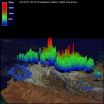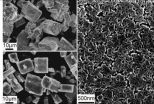(Press-News.org) DURHAM, N.C. -- Duke University engineers are layering atom-thick lattices of carbon with polymers to create unique materials with a broad range of applications, including artificial muscles.
The lattice, known as graphene, is made of pure carbon and appears under magnification like chicken wire. Because of its unique optical, electrical and mechanical properties, graphene is used in electronics, energy storage, composite materials and biomedicine.
However, graphene is extremely difficult to handle in that it easily "crumples." Unfortunately, scientists have been unable to control the crumpling and unfolding of large-area graphene to take advantage of its properties.
Duke engineer Xuanhe Zhao, assistant professor in Duke's Pratt School of Engineering, likens the challenge of controlling graphene to the difference between unfolding paper and wet tissue.
"If you crumpled up normal paper, you can pretty easily flatten it out," Zhao said. "However, graphene is more like wet tissue paper. It is extremely thin and sticky and difficult to unfold once crumpled. We have developed a method to solve this problem and control the crumpling and unfolding of large-area graphene films."
The Duke engineers attached the graphene to a rubber film that had been pre-stretched to many times its original size. Once the rubber film was relaxed, parts of the graphene detached from the rubber while other parts kept adhering to it, forming an attached-detached pattern with a feature size of a few nanometers. As the rubber relaxed, the detached graphene was compressed to crumple. But as the rubber film was stretched back, the adhered spots of graphene pulled on the crumpled areas to unfold the sheet.
"In this way, the crumpling and unfolding of large-area, atomic-thick graphene can be controlled by simply stretching and relaxing a rubber film, even by hands," Zhao said.
The results were published online in the journal Nature Materials.
"Our approach has opened avenues to exploit unprecedented properties and functions of graphene," said Jianfeng Zang, a postdoctoral fellow in Zhao's group and the first author of the paper. "For example, we can tune the graphene from being transparent to opaque by crumpling it, and tune it back by unfolding it."
In addition, the Duke engineers layered the graphene with different polymer films to make a "soft" material that can act like muscle tissues by contracting and expanding on demand. When electricity is applied to the graphene, the artificial muscle expands in area; when the electricity is cut off, it relaxes. Varying the voltage controls the degree of contraction and relaxation.
"The crumpling and unfolding of graphene allows large deformation of the artificial muscle," Zang said.
"New artificial muscles are enabling diverse technologies ranging from robotics and drug delivery to energy harvesting and storage," Zhao said. "In particular, they promise to greatly improve the quality of life for millions of disabled people by providing affordable devices such as lightweight prostheses and full-page Braille displays."
INFORMATION:
Zhao's work is supported by the National Science Foundation's (NSF) Triangle Materials Research Science and Engineering Center, NSF Materials and Surface Engineering program, and National Institutes of Health (NIH). Other members of the team are Duke's Qiming Wang and Qing Tu.
Controlled crumpling of graphene forms artificial muscle
2013-01-24
ELSE PRESS RELEASES FROM THIS DATE:
Motion control keeps electric car's 4 wheels -- and 4 motors -- on the road
2013-01-24
COLUMBUS, Ohio—It weighs half as much as a sports car, and turns on a dime—so its no surprise that the electric car being developed at Ohio State University needs an exceptional traction and motion control system to keep it on the road.
With four wheels that turn independently, each with its own built-in electric motor and set of batteries, the experimental car is the only one of its kind outside of commercial carmakers' laboratories.
"It is considered one of the promising future vehicle architectures," said Junmin Wang, assistant professor of mechanical engineering ...
Children's complex thinking skills begin forming before they go to school
2013-01-24
New research at the University of Chicago and the University of North Carolina at Chapel Hill shows that children begin to show signs of higher-level thinking skills as young as age 4 ½. Researchers have previously attributed higher-order thinking development to knowledge acquisition and better schooling, but the new longitudinal study shows that other skills, not always connected with knowledge, play a role in the ability of children to reason analytically.
The findings, reported in January in the journal Psychological Science, show for the first time that children's ...
SNPs associated with breast cancer risk alter binding affinity for pioneer factor FOXA1
2013-01-24
(Lebanon, NH)— Dartmouth scientists showed that more than half of all the SNPs associated with breast cancer risk are located in distant regions and bound by FOXA1, a protein required for estrogen receptor-α (ER) function according to a paper published in the journal Nature Genetics in November.
Jason Moore, PhD, a Third Century Professor of genetics, director of the Institute for Quantitative Biomedical Sciences, and associate director for bioinformatics at Dartmouth-Hitchcock Norris Cotton Cancer Center, and other researchers used a new methodology that combines ...
Tall and thin not so great for lung disease
2013-01-24
Tall, thin women face a greater risk of infection with nontuberculous mycobacteria (NTM), cousins of the organism that causes tuberculosis, according to researchers at National Jewish Health. Women with NTM infections also showed a weakened immune response associated with their fat cells, in a paper published in the Jan. 15, 2013, issue of The American Journal of Respiratory and Critical Care.
"Nontuberculous mycobacteria are widespread in the environment, yet only some people develop infections," said Edward Chan, MD, senior author and professor of medicine at National ...
Modifications of a nanoparticle can change chemical interactions with cell membranes
2013-01-24
Researchers at Syracuse University's Department of Biomedical and Chemical Engineering at L.C. Smith College of Engineering and Computer Science are studying the toxicity of commonly used nanoparticles, particles up to one million times smaller than a millimeter that could potentially penetrate and damage cell membranes.
In a recent article published along with cover art in the leading journal Langmuir entitled "Effects of nanoparticle charge and shape anisotropy on translocation through cell membranes," researchers Shikha Nangia, assistant professor of biomedical and ...
Planning for bacteria in cancer patients may help hospitals fight infections
2013-01-24
What cancerous conditions lead to what kinds of bacterial infections? If doctors knew, they could predict which patients would likely benefit from pre-treatment with certain kinds of antibiotics. A University of Colorado Cancer Center study published in this month's issue of the International Journal of Infectious Diseases shows the answer: E. coli and Klebsiella pneumoniae are especially prevalent in patients with lung and GI cancers, more so for Klebsiella if these patients have been treated previously with aminopenicillins.
"These are really dangerous infections. You ...
'Invisible' Filipino history in Annapolis documented by UMD researchers
2013-01-24
COLLEGE PARK, Md. – Filipinos have been an invisible minority in Annapolis, Maryland for more than a century. Now, researchers at the University of Maryland are using oral histories as a way to flesh out their life and times – documenting the incredible challenges they faced – and successes they celebrated.
After the Spanish-American War, the Philippines became a U.S. territory. Filipinos were brought to Annapolis – home of the Naval Academy – to serve as desk interns, fire fighters, construction laborers, messmen and stewards. In many cases, the Naval Academy replaced ...
NASA catches the very brief life of Tropical Cyclone Peta
2013-01-24
VIDEO:
This is a NASA TRMM satellite flyby of Tropical Cyclone Peta in the South Indian Ocean. TRMM revealed that rain was falling at a rate of up to 94 mm...
Click here for more information.
Infrared data from NASA's Aqua satellite has shown that soon after a low pressure system in northwestern West Australia became Tropical Storm Peta, it made landfall and started to fall apart.
Early on Jan. 22, the Joint Typhoon Warning Center (JTWC) gave System 93S a high chance for ...
ORNL research paves way for larger, safer lithium ion batteries
2013-01-24
OAK RIDGE, Tenn., Jan. 23, 2013 -- Looking toward improved batteries for charging electric cars and storing energy from renewable but intermittent solar and wind, scientists at Oak Ridge National Laboratory have developed the first high-performance, nanostructured solid electrolyte for more energy-dense lithium ion batteries.
Today's lithium-ion batteries rely on a liquid electrolyte, the material that conducts ions between the negatively charged anode and positive cathode. But liquid electrolytes often entail safety issues because of their flammability, especially as ...
NASA sees massive rainfall totals from Tropical Storm Oswald
2013-01-24
Tropical Storm Oswald's heavy rains have caused flooding in Queensland, Australia and NASA's TRMM satellite measured almost two feet of rain fell in certain areas.
Tropical cyclone Oswald's sustained winds have never been greater than 35 knots (~40.2 mph) but the storm's extreme rainfall has resulted in widespread flooding in Australia over northern Queensland. Many roads have been reported flooded resulting in some communities being cut off.
NASA's Tropical Rainfall Measuring Mission (TRMM) is a satellite that can measure rainfall from space. TRMM-based satellite precipitation ...





